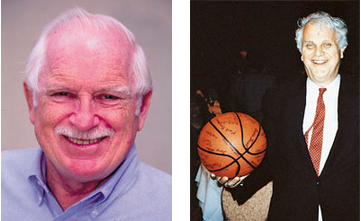heading
1999: Werner Stumm, Switzerland and James J. Morgan, USA
An ocean between them did not stop the two water researchers working closely together over a period of forty years.

James J. Morgan was based at the renowned California Institute of Technology (Caltech) in Pasadena, USA, while Werner Stumm (1934 – 1999) was active at the Swiss Federal Institute of Technology (ETH) in Zurich. Sadly, however, Professor Stumm passed away during the spring of that year.
Morgan, once a PhD student of Stumm’s, spoke for both at the Prize ceremony in Stockholm. As a 20-year-old, James Morgan became interested in how pollution was disturbing the oxygen balance of rivers. The United States passed its first water legislation in 1948, and by the mid-1950s this legislation was forcing the paper and pulp industry to look for ways of preventing the pollution it was causing.
““At that time, the foam from phosphate-containing detergents could reach waist-high above the water surface. My confrontation with that sight made me study chemistry for four years in parallel with my job.””
His interests developed in the direction of iron and manganese. Morgan heard of a professor at Harvard with similar interests, looked him up, and in 1960 became his PhD student. The professor was a Swiss by the name of Werner Stumm. At Harvard, Professor Stumm guided the education and research of the young Morgan and nine other doctoral students in water chemistry. These ‘academic children and grandchildren’ have become the leaders in the field of aquatic chemistry and populate the world’s major water research centres.
From that point on, Stumm and Morgan studied coagulation as a means of removing particles from water, and their pioneering papers are still widely cited. Particles carry toxic contaminants and make water unsatisfactory from an aesthetic point of view. A joint scientific paper in 1962 on chemically induced coagulation, and the resulting practical use, brought them a scientific award in 1963 from the American Water Works Association.
They continued to ask themselves how manganese (Mn) could be removed from water. The answer was to convert it into a solid form by oxidizing it.
Mn2+ ions in solution were found to adsorb to the surface of solid particles of the oxide MnO2. This reaction was greatly accelerated by a higher pH, i.e. increased alkalinity. An increase of one pH unit, e.g. pH 9 instead of pH 8, resulted in the reaction taking place a hundred times faster. The adsorbed manganese was oxidised by oxygen. Furthermore, it was discovered that MnO2, i.e. the product itself, was also a catalyst which promoted this reaction. These conclusions proved relevant to other contaminants, too, such as phosphorus and arsenite.
In California asbestos fibres were once discovered in the water. By raising the pH and adding aluminium, it was possible to remove 99.99 per cent of the hazardous asbestos. In addition to their studies of coagulation and flocculation, Stumm and Morgan were devoted to the education of future scientists. The editions of their book Aquatic Chemistry has become a bible and a worldwide citation classic for most scientists and students in this field. Between them, Stumm and Morgan have produced some 75 PhDs over the years. Seventy-five apostles who will carry their important knowledge out into the world.
In the year following the award, James Morgan was promoted to professor emeritus at Caltech. Since then he has lectured and written about his research into the chemistry and technology of water treatment, the scientific basis for establishing criteria and standards for water quality protection, and rates of manganese transformations in fresh and marine waters.